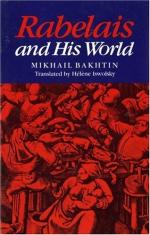
|
| Name: _________________________ | Period: ___________________ |
This test consists of 5 multiple choice questions, 5 short answer questions, and 10 short essay questions.
Multiple Choice Questions
1. When did the Russian Revolution occur?
(a) 1850.
(b) 1936.
(c) 1945.
(d) 1917.
2. Why does Bakhtin consider oaths, curses, and profanities elements of freedom?
(a) Populist uprisings often have profanities and oaths in their declarations.
(b) A person can form any sound into a curse or profanity.
(c) Slaves are prohibited from using such forms of speech.
(d) They are contrary to official modes of speech.
3. The episode in which Pantagruel and his companions defeat King Anarchus' knights combines:
(a) Slaughter with feasting.
(b) Human instinct with forethought.
(c) Nature with artifice.
(d) Love with hate.
4. How is the Rabelaisian use of tripe an excellent example of grotesque realism?
(a) It merges the positive and negative, or upper and lower, spheres of the body.
(b) It is a drug which offers the user a glimpse of a higher plane of existence.
(c) It combines fantasy with reality in one type of cuisine.
(d) It is the epitome of disgusting.
5. During the "feast of fools" and the "feast of the ass," laughter:
(a) Was forbidden everywhere but the marketplace.
(b) Was forbidden because of the sacredness of the festival.
(c) Was regulated by the town fools and farmers.
(d) Was encouraged even in church.
Short Answer Questions
1. What are the targets of the abusive language in Rabelais' prologue to the Third Book?
2. Why was Rabelais linked so closely to the Lyon fairs?
3. How does the prologue of _Pantagruel_ demonstrate the connection between literature and the marketplace?
4. Bakhtin connects Medieval "seriousness" most closely to:
5. What repressive organization was Bakhtin forced to join in order to continue writing?
Short Essay Questions
1. What does the prologue of _Pantagruel_ parody?
2. Describe the Catchpoles and what they symbolize.
3. How does the marketplace become an indicator of folk culture in general?
4. What is the underlying nature of all of Rabelais' images?
5. What was the effect of the suspension of social hierarchies during Carnival?
6. Why does the speaker of the prologue of the Third Book invite only good men to drink?
7. What was Bakhtin's relationship with the Russian Union of Writers?
8. What does tripe represent, in Bakhtin's analysis?
9. What do Bakhtin's examples of Rabelais' tales of extraordinary urination have in common?
10. What was the "feast of fools," and why was it a particularly festive laughter in the Middle Ages?
|
This section contains 894 words (approx. 3 pages at 300 words per page) |

|




